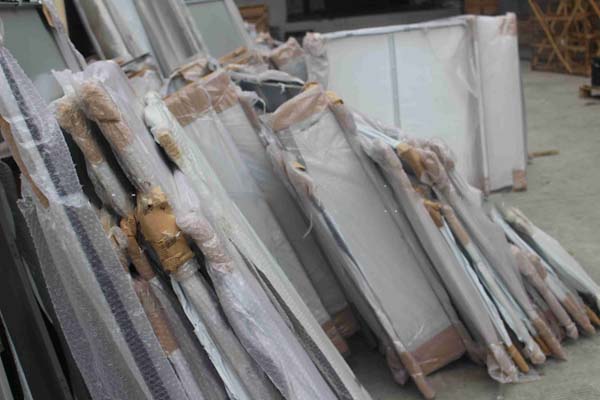China's earliest production and processing of aluminum veneer ceiling, one of the curtain wall manufacturers
Common materials for thermal insulation composite panels:Thermal insulation: the composite board commonly used insulation materials are: rock wool, glass fiber cotton, polyethylene, polyurethane, low thermal conductivity, with good thermal insulation effect.
Durability: a variety of studies show that, and more than 40 years abroad widely used confirmed that the commonly used materials of thermal insulation composite panels by special coating color steel plate shelf life in 10-15 years, after every 10 years spray anticorrosive coating, plate life can reach more than 35 years.
Beautiful: The clear lines of the profiled steel plate have more than dozens of colors, and the commonly used materials of the thermal insulation composite board can meet the needs of any style of building to achieve satisfactory results.
High strength: using high strength steel plate as the base material (tensile strength 5600 KG/CM) plus the most advanced design and roll forming, has excellent structural characteristics.
Fire prevention: the surface material and thermal insulation material of the color composite sandwich panel are non-combustible materials, and the common materials of thermal insulation composite panels can fully meet the requirements of fire protection specifications.
1. Vacuum insulation board, thermal conductivity 0.008W/(m · K)
Vacuum insulation board is made of inorganic fiber core material and high gas barrier composite film through vacuum packaging technology,aluminum honeycomb panelA high-efficiency thermal insulation board made of special interface mortar.
2. Aerogel insulation material, thermal conductivity 0.02W/(m · K)
Aerogel materials are known as the lightest solids in the world. Nano-silica aerogel as the main material, compounded by a special process,double curved plateIt has superior performance such as high temperature resistance, low thermal conductivity, low density, high strength, green environmental protection, waterproof and non-combustible, and superior sound insulation and shock absorption performance. It is an indispensable high-efficiency in metallurgy, chemical industry, national defense, aerospace and other fields. Thermal insulation material.
3. Foamed polyurethane, thermal conductivity 0.024W/(m · K)
The best performance in a single organic insulation material is polyurethane insulation material. The common materials of thermal insulation composite board are divided into on-site foaming polyurethane and factory prefabricated according to the process. Rigid foam polyurethane board. On-site foaming polyurethane is a rigid foam material with heat insulation and waterproof function, which is composed of isocyanate and polyol (combined polyether or polyester) as the main raw materials and additives.
4. Domestic extruded polystyrene board, thermal conductivity 0.028~0.030W/(m · K)
Extruded polystyrene board is also a kind of polystyrene board, but the production process is extrusion molding. Extruded polystyrene board referred to as XPS board, polystyrene resin or its copolymer as the main component,Hook up dragnet boardA rigid foam plastic product with a closed cell structure is obtained by heating extrusion molding with a small amount of additives to the commonly used materials of thermal insulation composite panels.
5. Foamed ceramic plate, thermal conductivity 0.10W/(m · K)
Foamed ceramics are clay tailings, ceramic fragments, river (lake) silt, mixed with feeding as the main raw materials, the use of advanced production technology and foaming technology, thermal insulation composite board commonly used materials by high temperature roasting and high porosity of closed-cell ceramic materials. The foamed ceramic plate is made of this inorganic porous ceramic material in the factory with low thermal conductivity, high temperature resistance, weather resistance, non-combustible insulation plate.

6. Phenolic board, thermal conductivity 0.032W/(m · K)
Phenolic board is a condensation polymer of phenol and formaldehyde ( Phenolic resin) mixed with other additives such as curing agent, foaming agent, surfactant and filler to make a porous phenolic foam board. The phenolic board produced abroad has good thermal insulation performance, and its thermal conductivity is lower than that of extruded polystyrene board. The sandwich insulation system in Japan uses a large number of phenolic boards. However, the current domestic promotion efforts are small, the production technology is relatively backward, and the thermal insulation performance of commonly used materials for thermal insulation composite panels is slightly worse than that of foreign Products.
7. Graphite polystyrene board, thermal conductivity 0.033W/(m · K)
Graphite polystyrene board is a kind of expanded polystyrene board. The common material of thermal insulation composite board is added with infrared reflector in polystyrene raw material. This material can reflect heat radiation and improve the thermal insulation performance of EPS by 30%. At the same time, the fire prevention performance can easily realize the span from B2 to B1.
8. Glass wool board, thermal conductivity 0.042W/(m · K)
Glass wool is the molten glass fiber, the formation of cotton-like material, chemical composition belongs to the glass class, insulation composite board commonly used material is a kind of inorganic fiber, with good molding, small volume density, thermal conductivity, thermal insulation, sound-absorbing performance, corrosion-resistant decoration, chemical performance stability. Glass wool board is a plate-shaped product with a certain rigidity made of glass wool applied thermosetting binder.
The advantages and disadvantages of the thermal insulation efficiency of these materials are mainly determined by the thermal conductivity of the material (its index is thermal conductivity). The more difficult the heat conduction of the material (that is, the smaller the thermal conductivity), the better the thermal insulation performance. Commonly used materials for thermal insulation composite panels Generally speaking, the common characteristics of thermal insulation materials are light, loose, porous or fibrous, and the internal non-flow of air to block heat conduction. Among them, inorganic materials have the characteristics of non-combustible, wide use temperature, good chemical resistance, and organic materials have low water absorption and better water impermeability.
Recommended:How to maintain the thermal insulation composite board Steel calcium plate pay attention to what place